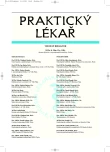Nutrition of children aged 1–3 years
Authors:
E. Kudlová; A. Slámová
Authors‘ workplace:
Přednosta: prof. MUDr. Vladimír Bencko, DrSc.
; Univerzita Karlova v Praze, 1. LF a VFN, Ústav hygieny a epidemiologie
Published in:
Prakt. Lék. 2008; 88(5): 272-275
Category:
Of different specialties
Overview
The mothers of 321 children aged 12–47 months (median 29 months), addressed in public premises across all 22 Prague districts, were asked to complete a questionnaire in a retrospective study. Data about basic demographic indicators and feeding habits were collected. We tested the statistically significant difference (p<0.05) between age groups. The mean breastfeeding duration of the 257 children already non-breastfed was 9 months. At 12 months of age 52.8 % of the children were still breastfed, and at 2 years the figure was 20.9%. Breastfeeding duration was positively associated with higher education. The most common reasons for breastfeeding cessation were: not enough milk (56.3 %) up to 5 months, not enough milk (33.4 %) and child refusal (34.1 %) between 6 and 11 months, and child’s age (47.4 %), child refusal (26.3 %), and mother’s fatigue (20.9 %) between 12 and 23 months. Mean age of supplementary food introduction was 6 months; 23.0 % of children started to receive supplementary food before they were 5 months old. On average, all the main food groups were consumed at least once a day, but the frequency of fruit, vegetable and white meat consumption and the proportion of children who daily consumed fruits and vegetables significantly decreased with age; the frequency of sweets, sweet bakery products, pork, smoked products, and fried food increased. Fruit and herbal teas, and milk were the most common beverages regardless of age. In addition to vitamin D recommended during winter month of the 2nd year of age (31.5 %), 33 % of children, significantly more 3-year-olds, received other food supplements, most often multivitamins, possibly with minerals.
Breastfeeding duration has increased but the main reasons for breastfeeding cessation still suggest the negative influence of incorrect breastfeeding technique and erroneous beliefs about child feeding. The food variety was on average satisfactory, but negative changes in the food selection occurred with increasing age. Improving lactation consultation during the first year of age, and nutrition consultation for toddlers, is desirable.
Key words:
feeding habits, nutrition, toddlers.
Sources
1. Bachrach,V.R., Schwarz,E., Bachrach,L.R. Breastfeeding and the risk of hospitalization for respiratory disease in infancy: a meta-analysis. Arch. Pediatr. Adolesc. Med., 2003, 157, p. 237-243.
2. Birch, L.L. Development of food preferences. Annu. Rev. Nutr., 1999, 19, p. 41-62.
3. Erkkola M, Pigg HM, Virta-Autio P, et al. Infant feeding patterns in the Finnish type I diabetes prediction and prevention nutrition study cohort. Eur. J. Clin. Nutr. 2005, 59, p. 107-113.
4. Fewtrell, M.S. The long-term benefits of having been breast-fed. Current Paediatrics, 2004, 14, p. 97–103.
5. Grjibovski, A.M., Yngve, A., Bygren, L.O., Sjostrom, M. Socio-demographic determinants of initiation and duration of breastfeeding in northwest Russia. Acta Paediatr., 2005, 94, p. 588-594.
6. Kudlová, E. Výživa kojenců a batolat: doporučení WHO a informace se kterými se setkávají čeští rodiče. Čas. lék. čes., 2005, 144, s. 540-544.
7. Kudlova E., Rames, J. Food consumption and feeding patterns of Czech infants and toddlers living in Prague. Eur. J. Clin. Nutr., 2007, 61, p. 239–247.
8. Lhotská, L., Vágnerová, J., Bláha, P. Wheeler, B. Trendy ve výživě nejmladších dětí. Hygiena, 1994, 39, s. 98-101.
9. Martin, R. M., Middleton, N., Gunnell, D. et al. Breast-Feeding and Cancer: the Boyd Orr Cohort and a Systematic Review With Meta-Analysis. J. Natl. Cancer Inst. 2005, 97, 19, p. 1446-1457.
10. Maynard, M., Gunnell, D., Emmett, P., Frankel, S. et al. Fruit,vegetables,and antioxidants in childhood and risk of adult cancer: the Boyd Orr cohort. J. Epidemiol. Community Health, 2003, 57, p. 218–225.
11. Maynard, M., Gunnell, D., Ness, A.R. et al. What influences diet in early old age? Prospective and cross-sectional analyses of the Boyd Orr cohort. Eur. J. Public Health, 2005, 16, p. 315-323 .
12. Nevoral, J. a kol. Výživa v dětském věku. Praha: H&H, 2003. 434 s. ISBN 80 86 022 93 5
13. Rowett Research Institute. Family diet and health in pre-war Britain. Scotland: Carnegie United Kingdom Trust, 1955.
14. Schneiderova, D., Millerova, D, Mydlilova, A., Paulova, M. Breastfeeding promotion and protection in the Czech Republic. Cent. Eur. J. Public Health, 2004, 12, p.110-112.
15. Vingraite, J., Bartkeviciute, R, Michaelsen, K.F. A cohort study of term infants from Vilnius, Lithuania: feeding patterns. Acta Paediatr., 2004, 93, p.1349-1355.
16. World Health Organization, UNICEF. Global strategy for infant and young child feeding. Geneva: WHO, 2003. 30 p. ISBN 92 4 156221 8.
17. World Health Organization. Diet, nutrition and the prevention of chronic diseases. Geneva: WHO, 2003. 149 p. ISBN 92 4 120916 X
Labels
General practitioner for children and adolescents General practitioner for adultsArticle was published in
General Practitioner

2008 Issue 5
- Advances in the Treatment of Myasthenia Gravis on the Horizon
- Memantine Eases Daily Life for Patients and Caregivers
- What Effect Can Be Expected from Limosilactobacillus reuteri in Mucositis and Peri-Implantitis?
- Metamizole vs. Tramadol in Postoperative Analgesia
- Memantine in Dementia Therapy – Current Findings and Possible Future Applications
Most read in this issue
- The late effects of xenobiotics. 1. effect mechanisms and their occurrence in the environment
- History, present problems and challenges in prevention of nosocomial infections
- Violence as a disquieting phenomenon in contemporary health services
- Treatment of tobacco dependence: prevention, diagnosis and treatment in General Practice
